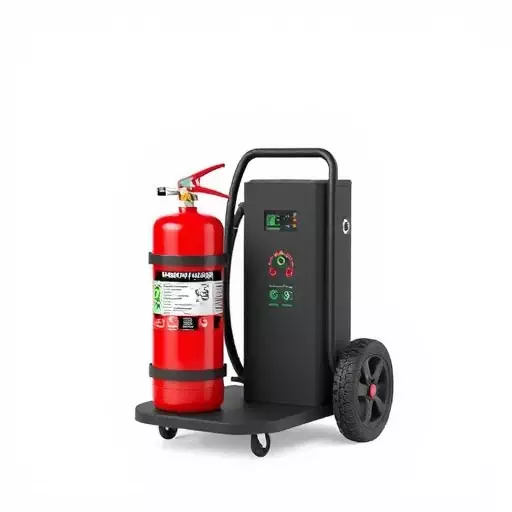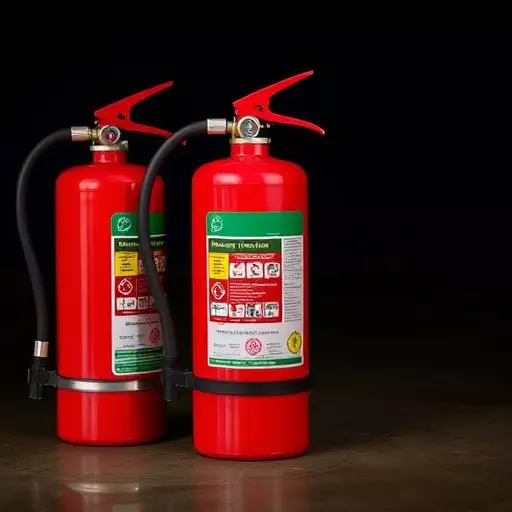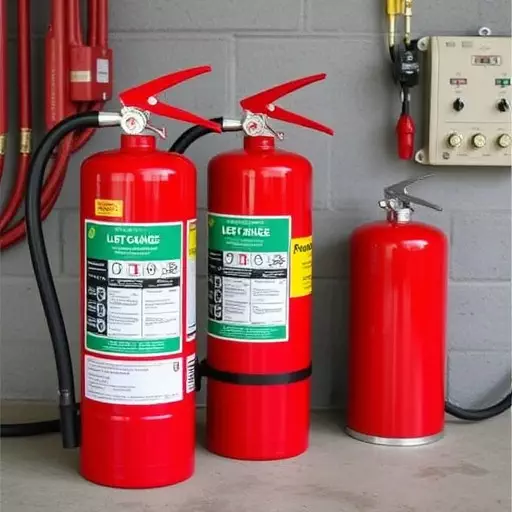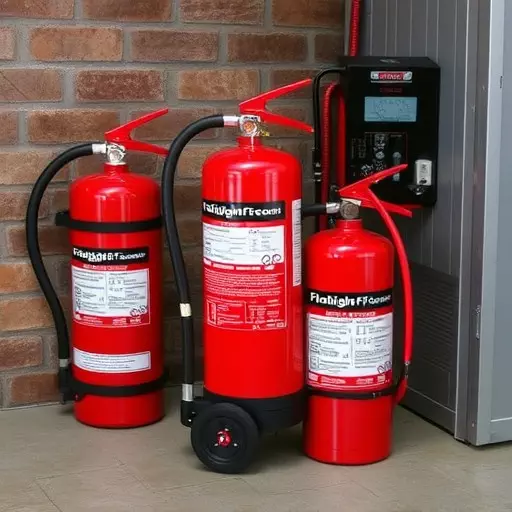In Fayetteville, fire extinguishers come in various types, with water, dry chemical, and CO2 models being common. Portable CO2 extinguishers require regular recharging every 1-12 months to maintain effectiveness. The recharge process involves pressure vessel refilling, leak testing, and inspection, guided by local regulations and usage frequency. Adhering to safety protocols, proper disposal of old cylinders, and regular maintenance are crucial for optimal performance during emergencies. Following manufacturer guidelines and local regulations ensures reliable operation of CO2 and portable fire extinguishers, with recharge cycles ranging from 5 to 10 years based on use and environmental factors. Regular inspections and professional recharge services in Fayetteville ensure maximum safety for both commercial and residential properties, complying with strict local regulations.
In every home and business, having fully functional fire extinguishers is paramount for safety. This comprehensive guide delves into the essential aspects of fire extinguisher recharge and maintenance, particularly focusing on CO₂ models and portable units. We’ll walk you through understanding different extinguisher types, the step-by-step recharge process, and efficient tips for regular inspection and local Fayetteville regulations to ensure your extinguishers are always ready when needed.
- Understanding Fire Extinguisher Types and Recharge Needs
- The Fire Extinguisher Recharge Process: Step-by-Step Guide
- CO₂ Fire Extinguishers: Maintenance and Recharge Techniques
- Portable Fire Extinguisher Recharge: Tips for Efficient Refilling
- Regular Inspection: Ensuring Your Extinguishers Are Ready
- Local Regulations and Requirements in Fayetteville for Fire Extinguisher Maintenance
Understanding Fire Extinguisher Types and Recharge Needs

Fire extinguishers come in various types, each with distinct features and recharge requirements. The most common categories include water, dry chemical, and CO2 (carbon dioxide) models. Understanding these differences is crucial when it comes to proper maintenance, especially for businesses and homes in Fayetteville.
Portable fire extinguishers, such as the CO2 variety, require regular recharging to ensure their effectiveness. The recharge process involves refilling the extinguisher’s pressure vessel with the appropriate agent and then testing its functionality. For instance, a CO2 extinguisher recharge process typically includes inspecting the gauge, checking for leaks, and ensuring the correct pressure is achieved before sealing it for use. This maintenance schedule varies based on the frequency of use and local regulations, but many professionals recommend recharging at least once a year to guarantee optimal performance during an emergency.
The Fire Extinguisher Recharge Process: Step-by-Step Guide

The fire extinguisher recharge process in Fayetteville involves several critical steps to ensure its effectiveness when needed. Here’s a step-by-step guide for both portable and CO2 types, commonly used in various settings across the city. First, locate the recharge valve on the extinguisher—it’s typically at the top or side—and assemble all necessary tools, including a suitable pressure gauge and a charged cylinder. Next, disconnect the extinguisher from its mounting bracket if applicable, allowing easy access to the internal components.
Proceed with disassembly: remove any safety pins, triggers, and seals. Then, attach the recharge hose to the valve, ensuring a secure connection. Once ready, connect the pressure gauge and begin recharging by filling the cylinder to the specified pressure levels recommended by the manufacturer. After charging, reassemble all parts accurately, checking for any leaks along the way using soapy water solution. Always follow safety protocols, dispose of old cylinders responsibly, and schedule regular maintenance to keep your fire extinguisher in top condition for CO2 or portable models alike.
CO₂ Fire Extinguishers: Maintenance and Recharge Techniques

CO₂ fire extinguishers are a popular choice for many businesses and homes due to their simple operation and effectiveness in suppressing certain types of fires, particularly those involving flammable gases or liquids. Maintaining these extinguishers is crucial to ensure they remain ready for use when needed. The recharge process involves several key steps: inspecting the extinguisher for any signs of damage or corrosion, ensuring the pressure level meets the manufacturer’s specifications (often checked with a gauge), and then replacing the carbon dioxide cartridge if necessary. This process should be performed by trained professionals who have access to proper equipment, such as those offered by local fire safety companies in Fayetteville. Regular recharging not only ensures optimal performance but also prolongs the lifespan of the extinguisher.
Proper maintenance includes keeping the extinguisher unobstructed and mounted securely, inspecting it periodically for any signs of damage or leaks, and ensuring that all components are in good working order. For portable CO₂ fire extinguishers, recharge cycles typically range from 5 to 10 years, depending on frequency of use and environmental conditions. It’s important to follow the manufacturer’s guidelines and local regulations regarding fire extinguisher maintenance and recharge to guarantee their reliability in an emergency situation.
Portable Fire Extinguisher Recharge: Tips for Efficient Refilling

When it comes to portable fire extinguisher recharge in Fayetteville, understanding the process is key to maintaining effective fire safety. The recharge process for a CO2 fire extinguisher involves several steps. First, inspect the extinguisher to ensure it’s in good working condition and has not exceeded its pressure limit. Then, drain the remaining gas from the cylinder while wearing protective gear. Next, replace the old cylinder with a new, properly sized one, ensuring it’s securely fastened. After filling the cylinder with CO2 gas to the required pressure, test the extinguisher’s functionality by releasing the trigger until all the gas is dispensed. Lastly, label and store the recharged extinguisher in an easily accessible location, ready for use in case of emergency.
Efficient portable fire extinguisher recharge requires adherence to safety protocols and regular maintenance. Regularly checking pressure levels and ensuring proper cylinder replacement are vital steps. Additionally, keeping records of recharge dates helps track device longevity. Remember that a well-maintained fire extinguisher can make all the difference during an emergency response, so prioritize these simple yet crucial steps in Fayetteville for enhanced fire safety.
Regular Inspection: Ensuring Your Extinguishers Are Ready

Regular inspections are a vital part of maintaining your fire safety system, especially when it comes to fire extinguishers. In Fayetteville, the recharge process for fire extinguishers should be handled by professionals who understand the specific needs of different types, such as portable fire extinguishers or CO2 extinguishers. Regular checks ensure that these devices are in optimal condition and ready to use in case of an emergency.
During these inspections, experts will examine various components, including pressure levels, hoses, nozzles, and seals. They’ll also test the extinguisher’s operation by activating it, ensuring its proper functioning. This proactive approach not only keeps your equipment in top shape but also provides peace of mind, knowing that you’re fully prepared to handle potential fires effectively.
Local Regulations and Requirements in Fayetteville for Fire Extinguisher Maintenance

In Fayetteville, like many cities across the US, local regulations dictate strict guidelines for fire extinguisher maintenance and recharge to ensure safety within commercial and residential properties. The city’s fire department sets forth specific requirements, including regular inspections and timely recharging of all portable fire extinguishers. This is particularly crucial for CO2 fire extinguishers, which are commonly used in various settings due to their effectiveness and ease of use. The recharge process involves replenishing the compressed carbon dioxide (CO2) that serves as the extinguishing agent, ensuring the device remains fully operational.
Business owners and residents alike must stay informed about these regulations to comply with local laws. Regular maintenance includes testing for pressure levels, examining the exterior for damage or corrosion, and verifying proper functionality during simulated discharge exercises. Professional fire extinguisher recharge services in Fayetteville are readily available to support businesses and homeowners in adhering to these requirements, ensuring peace of mind and the highest level of protection against potential fires.


